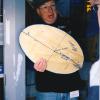Constellations and Asterisms
When we look into the sky at night we tend to group stars seeing stick figures and outlines of various objects. Eighty seven of these groupings have been given more or less official sanction as constellations. Informal groupings are called asterisms. The constellations were given their final borders in 1934 by the International Astronomical Union(IAU). Each constellation follows lines of latitude and longitude rather like many of our western states which have straight north/south and east/west borders. The entire sky is divided up among these official constellations more or less along the figures named in antiquity. In some cases allowances had to be made for stars that the ancients saw as part of two constellations. The medium bright star Alpheratz was used to mark the head of the Chained Maiden - Andromeda and as the northeastern corner of the Great Square that denoted the wings of the Flying Horse - Pegasus by the ancients. The IAU decided that Alpheratz would be placed in Andromeda. Yet we still refer to the Great Square using it as a convenient guide post for the northern summer and fall skies.
Asterisms come in two basic forms - those which are part of a constellation and those which span constellations. The Big Dipper in Ursa Major, the Teapot in Sagittarius and the Plieades in Taurus are examples of asterisms that comprise a compact region of a much larger constellation. The Great Square of Pegasus and the Summer Triangle are examples of well known asterisms spanning more than a single constellation.
Most people think that the Big Dipper is Ursa Major (Great Bear) but many more moderately bright stars make up the Bear than are in the Dipper. Similarly Sagittarius has many bright stars outside of those that make up the Teapot. The Seven Maidens of the Plieades are actually a tiny region of Taurus with the Bull occupying the large majority of this constellation.
Stars that could not be seen from Europe in the southern hemisphere were not formally given constellations until a French cleric Abbe [Abbott] Nicolas Louis de LaCaille was sent by the Pope with this charting the southern skies as his mission. The southern constellations contain many constellations which are named after Abbe LaCaille's tools. Even the Latin names barely disguise Telescopium and Microscopium. A little less familiar are Octans (an angle measuring device for one eighth of a circle - an octant, a forerunner of the nautical sextant). Two hundred and fifty years ago, Horologium (literally "hour logger") would have been instantly recognized but today we call it a clock. Any astronomer would recognize a "reticulum" as a reticle. What's a reticle? Its any eyepiece that has cross hairs.
Abbe LaCaille named a few collection of stars after whimsical beasts giving us Pavo (Peacock), Volans (Flying Fish), and Phoenix (the bird the rises from its own ashes). Two of the constellations named after animals are easily recognized Tucana (Toucan) and Chaemeleon. He named one constellation after the common house fly - Musca. Today the word musca is the scientific name for all flies and similar insects. He named two constellations after items found in a church Ara (Altar) and Crux (the Cross). Crux has many very bright first and second magnitude stars and is as easily recognized in the southern hemisphere as the Big Dipper is in the northern hemisphere. Perhaps Abbe LaCaille's greatest contribution was to split the huge constellation Argo (the ship of Jason and the Argonauts) into manageable pieces. It is now Vela (sails where we get our word veil), Puppis (Deck from which we get our term poopdeck), Carina (the keel) and Pyxis (the marine compass).
- Author:
- Leslie Coleman
- Entry Date:
- Aug 1, 2004
- Published Under:
- Leslie Coleman's Columns

